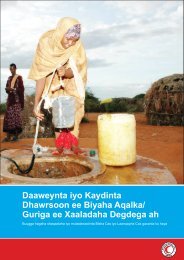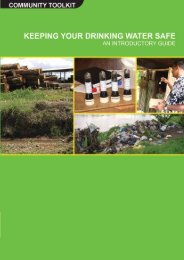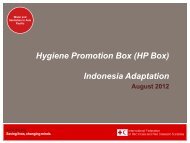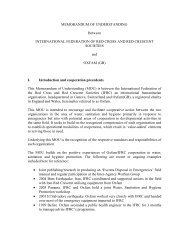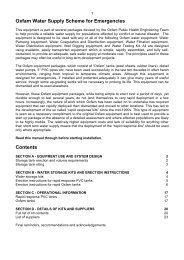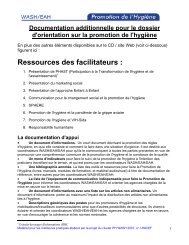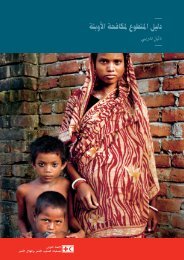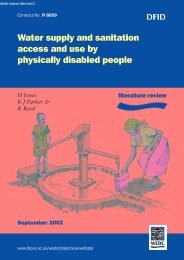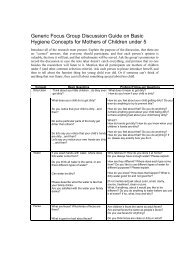Hygiene Promotion - IRC International Water and Sanitation Centre
Hygiene Promotion - IRC International Water and Sanitation Centre
Hygiene Promotion - IRC International Water and Sanitation Centre
You also want an ePaper? Increase the reach of your titles
YUMPU automatically turns print PDFs into web optimized ePapers that Google loves.
• develop an appropriate community-based hygiene education programme, <strong>and</strong>• develop a monitoring framework for tracking changes in behaviour / practices.The participatory nature of the baseline research also complemented the project’scommunity participation component, which includes animation, community mobilisation,training in O&M, <strong>and</strong> the training of community volunteers in hygiene education.The community-based hygiene education programme was piloted first. This resulted insome important changes to the programme based on community feedback, such aschanges to illustrations of practices, which would capture local <strong>and</strong> ethnic specificsituations. A local artist was contracted to assist in the design of educational materials.The programme draws from participatory approaches such as PHAST <strong>and</strong> other PLAmethods, including the development <strong>and</strong> utilisation of a health & hygiene game. The gameis adapted from a common local game <strong>and</strong> developed by the same artist. Efforts weremade to keep the programme appropriate both to participants’ needs (time, seasonality,resources, etc.) <strong>and</strong> to fit within the project's own needs <strong>and</strong> challenges, such asaccountability to both project participants <strong>and</strong> donors, availability of resources, etc. Theproject has high hopes for the use of <strong>and</strong> education from the game. The game proved tovery popular during the pilot <strong>and</strong> can be used by a variety of people <strong>and</strong> groups withincommunities.The education programme also focuses on facilitating discussion <strong>and</strong> exploration of thelinkages between certain existing practices (positive or negative) <strong>and</strong> the impact (effect) onlivelihoods as a whole. Cause <strong>and</strong> effect analysis of community identified risk practices is avaluable tool for education.Training of field staff within Partner Organisations contracted to carry out communitytraining is presently underway. These POs are responsible for facilitating part of theeducation programme with communities that entails initial in-depth analysis, prioritisation,action planning <strong>and</strong> monitoring. The POs will also train community water <strong>and</strong> sanitationcommittees (including hygiene volunteers) to continue education efforts, follow-up <strong>and</strong>monitoring. A major focus of the programme is that community volunteers will be equippedwith the necessary skills / resources to continue community-based education.The project is also exploring opportunities to team up with the MoH in delivering hygienemessages on market days to reach more women <strong>and</strong> in different local dialects. Informationfrom the baseline indicated that language was a barrier to receiving information from theradio, especially for women, coupled with the fact that many women do not have the timeto listen to the radio programmes. Radio programmes <strong>and</strong> messages are also beingexplored for encouraging traditional entertainment groups to create songs relating todifferent messages, as are elementary school art competitions (pictures of safe practices).Schools who take part could be provided with the resources for establishing simpleh<strong>and</strong>washing facilities (for example).34 <strong>Hygiene</strong> promotion



